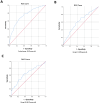The associations between skin advanced glycation end-products and Framingham cardiovascular risk in different age groups
- PMID: 40264511
- PMCID: PMC12011794
- DOI: 10.3389/fcvm.2025.1491643
The associations between skin advanced glycation end-products and Framingham cardiovascular risk in different age groups
Abstract
Objective: Advanced glycation end-products (AGEs) may contribute to the pathogenesis of atherosclerotic cardiovascular disease (ASCVD), potentially influencing its development and progression differently at various life stages. This study aimed to elucidate the associations between AGEs and the risk of ASCVD across different age groups.
Methods: In this cross-sectional study, 1,240 subjects were enrolled and divided into three groups (Group Ⅰ, 20-39 years old, n = 468; Group Ⅱ, 40-59 years old, n = 471; Group Ⅲ, 60-79 years old, n = 301). Skin AGEs were measured by skin autofluorescence (SAF). ASCVD risk was assessed by a validated Framingham risk score calculator. Other proven ASCVD risk factors were also measured, including glycosylated hemoglobin, uric acid, lipid profile, homocysteine, and cystatin C.
Results: An increasing trend in skin AGEs was observed from Group Ⅰ to Group Ⅲ. Skin AGEs were significantly associated with ASCVD risk in all subjects (OR 1.029, 95% CI 1.003-1.056, P = 0.018), independent of some of the proven cardiovascular risk factors. This association was particularly significant in individuals aged 40-59 and 60-79 (OR = 1.047, 95% CI: 1.025-1.069; OR = 1.022, 95% CI: 1.002-1.042; both P < 0.05). ROC analysis showed that skin AGEs predicted the diagnosis of medium or high ASCVD risk in the pooled group, Group Ⅱ, and Group Ⅲ.
Conclusion: Our study substantiates that skin AGEs play an important role as an independent risk factor for ASCVD, highlighting their significance beyond traditional risk assessment models, particularly in middle-aged and older populations.
Keywords: Framingham cardiovascular risk score; atherosclerotic cardiovascular disease; different age groups; skin advanced glycation end-products; skin autofluorescence.
© 2025 Wang, Liang, Zhou, Tang, Ye, Huang, Tang, Jiang and Pan.
Conflict of interest statement
The authors declare that the research was conducted in the absence of any commercial or financial relationships that could be construed as a potential conflict of interest.
Figures






Similar articles
-
Skin autofluorescence, arterial stiffness and Framingham risk score as predictors of clinical outcome in chronic kidney disease patients: a cohort study.Nephrol Dial Transplant. 2019 Mar 1;34(3):442-448. doi: 10.1093/ndt/gfx371. Nephrol Dial Transplant. 2019. PMID: 29378035
-
Advanced glycation end products measured by skin autofluorescence and subclinical cardiovascular disease: the Rotterdam Study.Cardiovasc Diabetol. 2023 Nov 28;22(1):326. doi: 10.1186/s12933-023-02052-7. Cardiovasc Diabetol. 2023. PMID: 38017418 Free PMC article. Clinical Trial.
-
Association between the tissue accumulation of advanced glycation end products and exercise capacity in cardiac rehabilitation patients.BMC Cardiovasc Disord. 2020 Apr 23;20(1):195. doi: 10.1186/s12872-020-01484-3. BMC Cardiovasc Disord. 2020. PMID: 32326893 Free PMC article.
-
Skin Autofluorescence-Indicated Advanced Glycation End Products as Predictors of Cardiovascular and All-Cause Mortality in High-Risk Subjects: A Systematic Review and Meta-analysis.J Am Heart Assoc. 2018 Sep 18;7(18):e009833. doi: 10.1161/JAHA.118.009833. J Am Heart Assoc. 2018. PMID: 30371199 Free PMC article.
-
Dietary glycation compounds - implications for human health.Crit Rev Toxicol. 2024 Sep;54(8):485-617. doi: 10.1080/10408444.2024.2362985. Epub 2024 Aug 16. Crit Rev Toxicol. 2024. PMID: 39150724
References
-
- Mukai H, Svedberg O, Lindholm B, Dai L, Heimbürger O, Barany P, et al. Skin autofluorescence, arterial stiffness and Framingham risk score as predictors of clinical outcome in chronic kidney disease patients: a cohort study. Nephrol Dial Transplant. (2019) 34:442–8. 10.1093/ndt/gfx371 - DOI - PubMed
LinkOut - more resources
Full Text Sources

